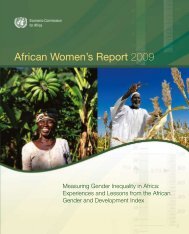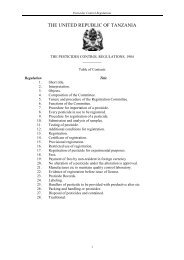Community-driven development decision tools for rural - IFAD
Community-driven development decision tools for rural - IFAD
Community-driven development decision tools for rural - IFAD
- No tags were found...
Create successful ePaper yourself
Turn your PDF publications into a flip-book with our unique Google optimized e-Paper software.
Managing expectations about paceDuring the implementation of CDD projects, there is a trade-off between the pace of institutional<strong>development</strong> of the CBOs, which naturally takes time, and the political objective of quicklyachieving the project’s physical targets. The result is pressure from the central government toabandon the CDD approach and return to top-down ways of implementing project componentsthat envisage construction work or other similarly “visible” targets. Since slow progress onconstruction can be a cause of slower than anticipated loan disbursement, project supervisorsbegin to worry that their own per<strong>for</strong>mance will be judged badly. There<strong>for</strong>e, support thegovernment pressure <strong>for</strong> changing the CDD approach.One way to deal with this problem is to avoid unrealistic projections of physical progress anddisbursement of funds on construction activities that depend on the <strong>development</strong> of the CBOs.Experience suggests that many project designers disregard and insufficiently analyse the linkagesbetween the expected <strong>development</strong> of the CBOs and the disbursement of funds to construct thephysical infrastructure that CBOs should plan, help to construct and finally manage. This leads tomisunderstandings and false expectations, with consequent disillusionment and negative reactions.Managing expectations of per<strong>for</strong>manceBox 39 presents three quotes from a World Bank study of CDD.They summarize the per<strong>for</strong>mance expected from the front lineoperators of CDD projects and from their employers andsupervisors. Front line operators’ per<strong>for</strong>mance is hard to control,as is the case in all “coping” organizations 43 that are entrustedwith per<strong>for</strong>ming dispersed field-level tasks. The problem iscomplicated by the need to use a relatively large number ofpeople recruited from the local village. These are often peoplewith little education, but who have a good understanding of thelocal setting. They are paid fairly low salaries, but given status andpower in the communities that may be well above that of theirfamily of origin and level of income.People’s per<strong>for</strong>mance depends on their personal motivationsand level of training and on the culture of the organization <strong>for</strong>which they work (i.e. the system of incentives that confrontsthem). A system of incentives is comprised of targets and rewardsand penalties <strong>for</strong> achieving or missing the targets. The extent of adonor’s and government’s commitment to CDD can beunderstood by analysing the system of incentives <strong>for</strong> the staff,managers and supervisors of the project, which should be built onper<strong>for</strong>mance indicators that properly reflect the special nature ofthe CDD project.The need <strong>for</strong> special indicators of CDDproject per<strong>for</strong>manceDesigning a system of incentives oriented towards CDDobjectives requires making several <strong>decision</strong>s, including• the targets that project managers and other key actorsshould achieve;Box 39Expected per<strong>for</strong>mancelevel of communityfacilitators“<strong>Community</strong> facilitators arecritical actors in building theparticipatory and targetingprocess, sometimesnegotiating through localelite dominance”.“To act effectively, facilitatorsmust be culturally andpolitically sensitive, haveleadership, organizationaland training capacity and bemotivated by an enablingsystem of incentivescompatible with theobjectives of their tasks”.“Funding agencies mustapply patience, endurance,willingness to stick to theultimate objective, closemonitoring of the quality ofinstitutional <strong>development</strong>progress, acceptance ofslow and gradual but steadyprogress and a strong ethicof learning by doing”.Source: Ghazala Mansuri andVijayendra Rao. Evaluating community<strong>driven</strong><strong>development</strong>: A review of theevidence, draft paper February 2003.43 “Coping Organizations” are well defined and dealt with in J.Q. Wilson’s book, “What Government Agencies Do and Why theyDo It”, 1988.79
















